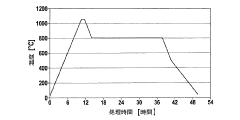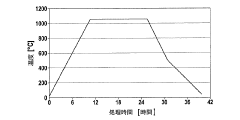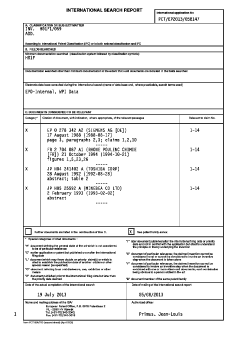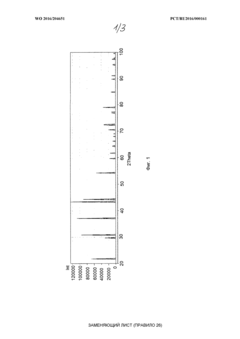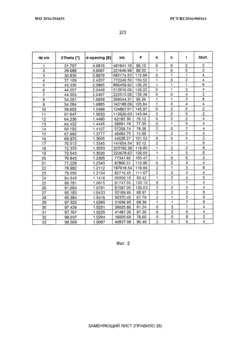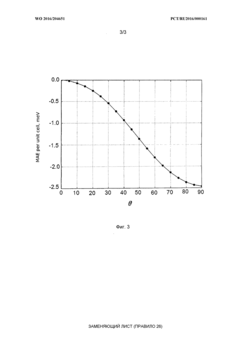Tungsten And Emerging Trends In Magnet Technology
Tungsten Magnets: Background and Objectives
Tungsten magnets represent a significant advancement in the field of magnetic materials, offering unique properties that have garnered attention in various industries. The development of tungsten-based magnets can be traced back to the early 20th century, with notable progress occurring in recent decades. These magnets have emerged as a promising alternative to traditional rare-earth magnets, addressing concerns related to supply chain vulnerabilities and environmental impact.
The evolution of tungsten magnet technology has been driven by the increasing demand for high-performance magnetic materials in applications such as electric motors, wind turbines, and medical devices. As global energy policies shift towards sustainability, the need for efficient and environmentally friendly magnetic materials has become more pressing. Tungsten magnets have shown potential in meeting these requirements, offering a balance between magnetic performance and resource availability.
One of the primary objectives in tungsten magnet research is to enhance their magnetic properties, particularly their remanence and coercivity. Scientists and engineers are exploring various approaches, including nanostructuring and alloying, to optimize the magnetic characteristics of tungsten-based materials. The goal is to develop magnets that can compete with or surpass the performance of rare-earth magnets in specific applications while offering advantages in terms of cost and sustainability.
Another critical objective is to improve the manufacturing processes for tungsten magnets. Current production methods often involve complex and energy-intensive steps, which can limit large-scale adoption. Researchers are investigating novel synthesis techniques and processing methods to streamline production, reduce costs, and minimize environmental impact. This includes exploring additive manufacturing technologies and innovative powder metallurgy approaches.
The tungsten magnet industry is also focusing on expanding the range of applications for these materials. While they have shown promise in certain niche markets, there is a concerted effort to broaden their use in mainstream applications. This involves not only improving the magnets' performance but also addressing challenges related to thermal stability, corrosion resistance, and long-term reliability in diverse operating environments.
As the field progresses, there is a growing emphasis on understanding the fundamental physics and materials science underlying tungsten magnets. This includes investigating the magnetic domain structures, the role of crystal defects, and the interplay between composition and magnetic properties. Advanced characterization techniques, such as neutron diffraction and high-resolution electron microscopy, are being employed to gain deeper insights into these materials at the atomic and nanoscale levels.
Market Analysis for Tungsten-based Magnets
The global market for tungsten-based magnets has been experiencing steady growth, driven by increasing demand across various industries. The automotive sector, particularly in the production of electric vehicles, has emerged as a significant consumer of these magnets due to their superior magnetic properties and high temperature resistance. Additionally, the aerospace and defense industries continue to be major contributors to market expansion, utilizing tungsten-based magnets in critical components and systems.
In recent years, the electronics and renewable energy sectors have also shown increased adoption of tungsten-based magnets. The miniaturization trend in consumer electronics and the growing emphasis on energy-efficient technologies have further boosted market demand. The wind energy industry, in particular, has been a key driver, with tungsten-based magnets being essential components in wind turbine generators.
Market analysis indicates that Asia-Pacific dominates the global tungsten-based magnet market, with China being the largest producer and consumer. The region's strong manufacturing base and growing industrial sectors contribute significantly to this market leadership. North America and Europe follow, with their advanced technological industries and focus on sustainable energy solutions driving demand.
The market is characterized by a high degree of consolidation, with a few key players controlling a significant share. These companies are investing heavily in research and development to improve the performance and cost-effectiveness of tungsten-based magnets. This has led to innovations in manufacturing processes and the development of new alloys that enhance magnetic properties while reducing reliance on rare earth elements.
Despite the positive growth trajectory, the market faces challenges. The volatility in raw material prices, particularly tungsten, can impact production costs and market stability. Environmental concerns associated with tungsten mining and processing have also led to increased regulatory scrutiny, potentially affecting supply chains.
Looking ahead, the market for tungsten-based magnets is expected to continue its growth trend. Emerging applications in robotics, medical devices, and advanced manufacturing processes are likely to create new opportunities. The ongoing shift towards clean energy and electrification across industries is anticipated to sustain long-term demand for these high-performance magnets.
Current Challenges in Tungsten Magnet Technology
Tungsten-based magnets face several significant challenges in the current technological landscape. One of the primary issues is the high cost associated with tungsten production and processing. The extraction and refining of tungsten ore are energy-intensive processes, leading to elevated manufacturing expenses. This cost factor limits the widespread adoption of tungsten magnets in various applications, particularly in consumer electronics and automotive industries where price sensitivity is a crucial consideration.
Another major challenge is the environmental impact of tungsten mining and processing. The extraction of tungsten often involves open-pit mining, which can lead to habitat destruction and soil erosion. Additionally, the chemical processes used in tungsten refinement can result in the release of harmful pollutants, raising concerns about long-term ecological sustainability and regulatory compliance.
The limited availability of tungsten resources poses a significant challenge to the magnet industry. Tungsten deposits are geographically concentrated, with China controlling a substantial portion of the global supply. This concentration of resources creates potential supply chain vulnerabilities and geopolitical risks, which can affect the stability of tungsten magnet production and pricing.
From a technical perspective, tungsten magnets face challenges in achieving high magnetic performance comparable to rare-earth magnets. While tungsten-based materials offer excellent thermal stability and corrosion resistance, they generally exhibit lower magnetic strength and energy product compared to neodymium or samarium-cobalt magnets. This performance gap limits their application in high-end magnetic devices that require extremely strong magnetic fields.
The manufacturing process of tungsten magnets also presents challenges. The high melting point of tungsten (3422°C) makes it difficult to process using conventional metallurgical techniques. This necessitates specialized equipment and expertise, which can be a barrier to entry for new manufacturers and limit production scalability.
Recycling and end-of-life management of tungsten magnets remain problematic. Unlike rare-earth magnets, which have established recycling processes, tungsten magnets lack efficient recycling methods. This not only contributes to waste accumulation but also fails to alleviate the pressure on primary tungsten resources.
Lastly, there is a challenge in research and development to improve the magnetic properties of tungsten-based materials. While significant progress has been made in enhancing the performance of rare-earth magnets, tungsten magnets have seen comparatively less innovation. This gap in R&D focus hinders the potential for breakthrough advancements that could make tungsten magnets more competitive in high-performance applications.
Existing Tungsten Magnet Solutions
01 Magnetic properties of tungsten-based alloys
Tungsten-based alloys can exhibit unique magnetic properties when combined with other elements. These alloys can be engineered to have specific magnetic characteristics, such as high coercivity or saturation magnetization, making them suitable for various applications in magnetic devices and systems.- Magnetic properties of tungsten-based alloys: Tungsten-based alloys can exhibit unique magnetic properties when combined with other elements. These alloys may demonstrate improved magnetic strength, coercivity, and thermal stability compared to traditional magnets. The specific composition and manufacturing process can be tailored to achieve desired magnetic characteristics for various applications.
- Tungsten as a component in permanent magnets: Tungsten can be incorporated into permanent magnet compositions to enhance their performance. It may be used as an additive or alloying element in rare-earth magnets or other types of permanent magnets. The addition of tungsten can potentially improve magnetic properties such as remanence, coercivity, and maximum energy product.
- Magnetic thin films containing tungsten: Thin films containing tungsten can be deposited to create magnetic structures with specific properties. These films may be used in various applications such as magnetic recording media or magnetic sensors. The presence of tungsten in the film composition can influence the magnetic anisotropy, domain structure, and overall magnetic behavior of the thin film.
- Tungsten's role in soft magnetic materials: Tungsten can be utilized in soft magnetic materials to modify their magnetic properties. It may be added to alloys or composites to adjust the magnetic permeability, saturation magnetization, or core losses. These materials can find applications in transformers, inductors, or magnetic shielding where specific soft magnetic characteristics are required.
- Magnetic nanostructures incorporating tungsten: Tungsten can be incorporated into magnetic nanostructures to tailor their properties at the nanoscale. These nanostructures may include nanoparticles, nanowires, or nanocomposites. The presence of tungsten can influence the magnetic behavior, surface properties, and stability of these nanostructures, potentially leading to novel applications in fields such as biomedicine or data storage.
02 Tungsten as a component in permanent magnets
Tungsten can be used as a component in permanent magnet compositions, often in combination with rare earth elements or other transition metals. These magnets can offer improved thermal stability, corrosion resistance, and magnetic performance compared to conventional magnets.Expand Specific Solutions03 Magnetic thin films and coatings containing tungsten
Tungsten can be incorporated into magnetic thin films and coatings to enhance their properties. These films may exhibit improved magnetic anisotropy, reduced eddy current losses, or enhanced wear resistance, making them suitable for use in magnetic recording media or magnetic sensors.Expand Specific Solutions04 Tungsten in soft magnetic materials
Tungsten can be used in soft magnetic materials to improve their magnetic properties. These materials may have high permeability, low coercivity, and reduced core losses, making them suitable for applications in transformers, inductors, and magnetic shielding.Expand Specific Solutions05 Magnetic nanostructures and nanoparticles containing tungsten
Tungsten can be incorporated into magnetic nanostructures and nanoparticles to tailor their magnetic properties. These nanostructures may exhibit unique magnetic behaviors, such as superparamagnetism or enhanced magnetoresistance, making them promising for applications in spintronics and magnetic data storage.Expand Specific Solutions
Key Players in Tungsten Magnet Industry
The tungsten and magnet technology sector is in a dynamic growth phase, driven by increasing demand in electronics, renewable energy, and automotive industries. The market size is expanding rapidly, with projections indicating significant growth in the coming years. Technologically, the field is advancing quickly, with companies like TDK Corp., Toshiba Corp., and Samsung Electronics Co., Ltd. leading innovation. Emerging players such as Xiamen Tungsten Co., Ltd. and Chongyi Zhangyuan Tungsten Co., Ltd. are making strides in tungsten-based materials, while established firms like Robert Bosch GmbH and Applied Materials, Inc. are integrating these advancements into broader applications. Research institutions like Central South University and the University of Science & Technology Beijing are contributing to fundamental breakthroughs, indicating a collaborative ecosystem that's pushing the boundaries of magnet technology.
TDK Corp.
Robert Bosch GmbH
Innovations in Tungsten Magnet Research
- A magnetic material composed of transition metals (60-90% by weight), rare earth metals (10-20% by weight), and tungsten (5-25% by weight) offers enhanced stability and reduced raw material costs, with tungsten stabilizing the lattice structure and promoting anisotropy, allowing for efficient production without supply restrictions.
- A magnetic material based on the WMnB crystalline form, with a composition of 25% tungsten, 25% manganese, and the rest boron, which provides strong magnetic moment, high magnetic anisotropy, and chemical inertness through strong covalent interactions, replacing rare earth elements and enhancing corrosion resistance.
Environmental Impact of Tungsten Magnets
The environmental impact of tungsten magnets is a critical consideration in the ongoing development and application of magnet technology. Tungsten, as a key component in high-performance magnets, presents both advantages and challenges from an environmental perspective.
One of the primary environmental concerns associated with tungsten magnets is the mining and extraction process of tungsten ore. This process can lead to significant land disturbance, habitat destruction, and potential water pollution if not managed properly. The energy-intensive nature of tungsten extraction also contributes to increased carbon emissions, further exacerbating environmental issues.
However, tungsten magnets offer several environmental benefits that offset some of these concerns. Their superior magnetic properties allow for the development of more efficient and compact electrical devices, potentially reducing overall energy consumption. This efficiency can lead to decreased greenhouse gas emissions in various applications, from electric vehicles to wind turbines.
The durability and longevity of tungsten magnets also contribute to their environmental profile. Their resistance to demagnetization and corrosion means they require less frequent replacement, reducing waste and the need for additional resource extraction over time. This longevity is particularly valuable in renewable energy applications, where magnet reliability is crucial for long-term performance.
Recycling and resource recovery present both challenges and opportunities for tungsten magnets. While the recycling process for these magnets can be complex and energy-intensive, it is becoming increasingly important as a means to reduce the environmental impact of primary tungsten production. Advances in recycling technologies are making it more feasible to recover tungsten from end-of-life products, potentially creating a more circular economy for this valuable resource.
The use of tungsten magnets in clean energy technologies further underscores their environmental significance. These magnets play a crucial role in improving the efficiency of wind turbines and electric vehicle motors, contributing to the broader transition towards renewable energy sources and sustainable transportation.
As environmental regulations become more stringent, the magnet industry is increasingly focusing on developing more sustainable production methods for tungsten magnets. This includes exploring alternative extraction techniques, optimizing manufacturing processes to reduce waste and energy consumption, and investigating potential substitutes that may offer similar performance with a lower environmental footprint.
In conclusion, while the production of tungsten magnets does pose certain environmental challenges, their long-term benefits in enabling more efficient and sustainable technologies make them a critical component in the ongoing transition to a more environmentally friendly future. Balancing these factors will be key to maximizing the positive environmental impact of tungsten magnets while minimizing their negative effects.
Supply Chain Considerations for Tungsten Magnets
The supply chain for tungsten magnets is a critical aspect of the emerging trends in magnet technology. As tungsten becomes increasingly important in the development of high-performance magnets, understanding and optimizing the supply chain is essential for manufacturers and researchers alike.
Tungsten, a rare metal with unique properties, is primarily sourced from a limited number of countries, with China being the dominant producer. This geographical concentration of supply introduces potential risks and vulnerabilities to the tungsten magnet supply chain. Diversification of sources and the development of alternative mining locations are becoming key strategies to mitigate these risks.
The extraction and processing of tungsten ore require specialized techniques and equipment, which can be both costly and environmentally challenging. As environmental regulations become more stringent globally, companies involved in tungsten production are investing in cleaner and more efficient extraction methods. This shift towards sustainable practices is likely to impact the overall cost and availability of tungsten for magnet production.
Recycling and circular economy initiatives are gaining traction in the tungsten supply chain. The recovery of tungsten from end-of-life products, including magnets, is becoming an increasingly important source of raw material. This not only reduces dependence on primary mining but also addresses environmental concerns associated with waste disposal.
The manufacturing process for tungsten magnets involves multiple stages, each requiring specific expertise and equipment. From powder metallurgy to sintering and machining, the production chain is complex and often involves multiple suppliers and manufacturers. Ensuring quality control and consistency throughout this process is crucial for producing high-performance magnets.
Global trade dynamics and geopolitical factors play a significant role in the tungsten magnet supply chain. Trade policies, tariffs, and international relations can impact the availability and cost of tungsten and finished magnets. Manufacturers must navigate these complexities to maintain a stable supply of materials and components.
As demand for high-performance magnets grows in various industries, including renewable energy and electric vehicles, the pressure on the tungsten supply chain is expected to increase. This may lead to innovations in material efficiency, substitution strategies, and the development of new magnet technologies that reduce reliance on critical raw materials like tungsten.

